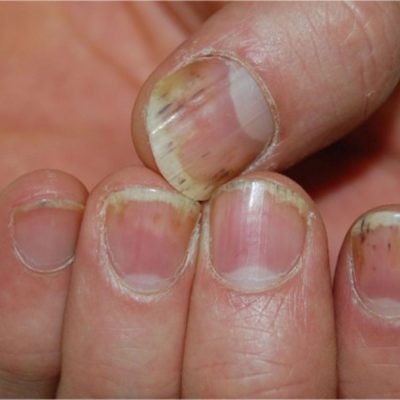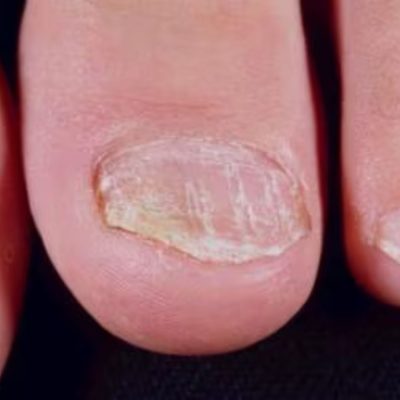Nail Psoriasis
Nail psoriasis is a common condition affecting the nails of people, especially those already suffering from psoriasis, a chronic skin disorder. It causes changes in the appearance and texture of fingernails and toenails, leading to discomfort and sometimes pain. At SkinAccess Clinics, we provide an expert diagnosis and treatment of nail psoriasis, helping you manage the symptoms and improve your quality of life.

What is Nail Psoriasis?
Nail psoriasis is a form of psoriasis specifically affecting the nails. It is estimated that around 50% of psoriasis patients will experience nail involvement at some point. It can occur on its own or alongside other forms of psoriasis. It can significantly affect the appearance of the nails, leading to issues with self-esteem and daily functioning.
Symptoms of Nail Psoriasis
Nail psoriasis can affect the fingernails and toenails and can manifest in various ways. Some common symptoms include
Pitting
Small depressions or pits in the nail surface are a hallmark sign of nail psoriasis. These pits can vary in number and may be shallow or deep.
Discolouration
Nails could change colour and turn yellow, brown or white. Red or orange spots may also appear under the nails.
Thickening
Nails could thicken and become difficult to trim. This could lead to discomfort or pain.
Onycholysis
This is where the nail separates from the nail bed, creating a gap under the nail where dirt and debris can accumulate, leading to further issues.
Subungual Hyperkeratosis
A buildup of thick skin (keratin) may develop under the nail, causing the nail to lift and become distorted.
Crumbling
In severe cases, the nails could become brittle and crumble.
Causes of Nail Psoriasis
Nail psoriasis is primarily caused by an overactive immune system, triggering inflammation and excessive growth of skin cells. This process affects the nails, leading to the characteristic symptoms of nail psoriasis.
The likelihood of developing nail psoriasis increases if there is a family history of psoriasis. Certain genetic markers have been associated with a higher risk.
Psoriasis is an autoimmune condition where the body’s immune system mistakenly attacks healthy skin cells. This leads to rapid cell turnover and inflammation.
Stress, infections, nail injuries and cold weather can act as triggers and worsen nail psoriasis symptoms.

Diagnosis of Nail Psoriasis
A proper diagnosis involves a thorough examination by a dermatologist. This involves an examination of the nails to assess the pattern and extent of the symptoms. The characteristic changes in nail appearance are usually sufficient to make a diagnosis. A family and medical history of psoriasis helps to understand the likelihood of developing nail psoriasis. In some rare cases, a nail biopsy may be performed to rule out other similar conditions.
Management and Treatment of Nail Psoriasis
Nail psoriasis is a difficult condition to treat. There are several treatment options available to manage symptoms and improve nail appearance. SkinAccess Clinics offers a range of care and treatment options tailored to suit each patient’s specific needs.
➥ Topical Treatments:
- Corticosteroids: These are often the first form of treatment and help to reduce inflammation and slow down the overactive immune response.
- Calcipotriol: A vitamin D derivative, it helps to slow down skin cell production and reduce the thickening of the nails.
➥ Systemic Medications:
- Oral Medications: For severe cases, oral medications may be prescribed to reduce the immune system’s activity and alleviate symptoms.
- Biologics: These target specific parts of the immune system. They are particularly useful in treating moderate to severe cases.
➥ Intralesional Injections: Corticosteroids may be directly injected into the nail bed to reduce inflammation and improve the appearance of the nails.
➥ Ultraviolet (UV) Light Therapy: Narrowband UV light therapy helps by slowing down the rapid growth of skin cells and reducing inflammation.
➥ Nail Care & Lifestyle Modifications:
- Proper Nail Care: Keeping nails trimmed and clean, avoiding nail trauma and moisturizing the hands and nails regularly can help manage symptoms.
- Avoiding Triggers: Identifying and avoiding triggers such as stress, nail injuries or even some medications, can help prevent flare-ups.
Conclusion
Nail psoriasis can be a challenging condition, but with the right care and treatment plan, it is possible to manage symptoms and improve the appearance of your nails. At SkinAccess Clinics, we offer an expert diagnosis and a range of treatment options tailored to best suit your condition and help you achieve healthier, stronger nails. If you are experiencing symptoms of nail psoriasis, schedule a consultation with us today to explore your treatment options and take the first step toward better nail health!
